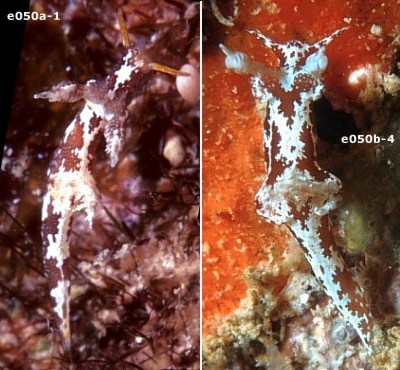
Trapania euryeia
Gosliner & Fahey, 2008
Order: NUDIBRANCHIA
Suborder: DORIDINA
Superfamily: ANADORIDOIDEA
Family: Goniodorididae
DISTRIBUTION
This species has been reported from Reunion, Papua New Guinea, Indonesia: Sulawesi and Bali, Okinawa, Marshall Islands, Midway Atoll and Hawaii (present study). [see messages below for possible records from South Africa and Queensland, Australia].
PHOTO
Upper: Marshall Islands, showing variation in distribution of white and brown coloration on the body, and one of the specimens, e050a-1, has orange anterior tentacles. Size range: e050a-1 = 6 mm, e050 = 16 mm long. Photos: Scott Johnson. Lower left: CASIZ 097448, Maui, Hawaiian Islands, 7 mm. Photo: T. Gosliner. Lower right: CASIZ 172858. Radular morphology. Scale = 10 µm.
The body is translucent brown often punctuated with small translucent straw coloured spots. Overlaying this background colour is a symmetrical pattern of white - ranging from opaque white to cream-white. The white pattern is not consistent enough to describe in detail but it usually includes a white median patch on the head, a Y or V shape in the midline between the gills and the rhinophores, and a broken median band down the posterior part of the body/foot behind the gills. The pattern is very symmetrical, the left side being a mirror image of the right.
The oral tentacles may be brown and white speckled like the body, or they can have a yellowish tinge, sometimes without any brown speckling. A similar variation can be seen in the colour of the dorso-lateral preocesses. Similarly, the gills and rhinophores are translucent celar with varying amounts of brown, white and sometimes yellowish colouration.
This species is similar in colour and radular morphology to T. brunnea. Records of this species have previously been clustered in the Forum as Trapania cf brunnea, but as I have mentioned in comments to previous messages, I can't even be sure from external photos if they are all the same species. Now that we know the radula is very similar in shape to that of T. brunnea, the relationship between these similarly coloured animals is unfortunately no clearer. It is possible that T. brunnea is a temperate population of a widespread tropical species, which would be unusual, but not unique. Clearly we still have work to do on this colour complex.
The living animal is reported to grow to at least 10 mm in length.
Note: This animal was previously known on the Forum as Trapania cf. brunnea.
- Gosliner, T.M. & Fahey, S.H. (2008) Systematics of Trapania (Mollusca: Nudibranchia: Goniodorididae) with descriptions of 16 new species Systematics and Biodiversity, 6 (1): 53-98
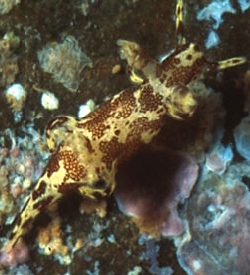
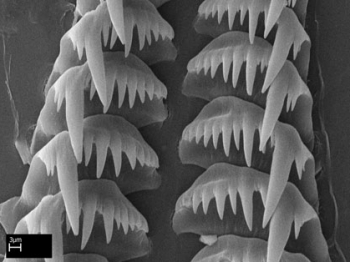
Rudman, W.B., 2008 (March 10) Trapania euryeia Gosliner & Fahey, 2008. [In] Sea Slug Forum. Australian Museum, Sydney. Available from http://www.seaslugforum.net/find/trapeury
Related messages
Re: Trapania euryeia? from Amami Ooshima Islands, Japan.
March 2, 2009
From: Brian Mayes
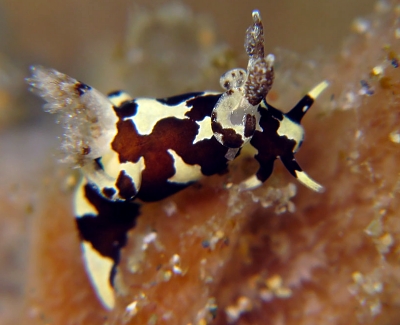
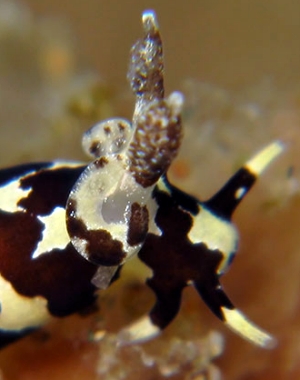
Concerning message #9455:
Dear Bill,
Here are some photos of Trapania euryeia eating a sponge. It also has no small white spots in the dark brown patches like those submitted by Jun Inamoto in March 2008.
By the way - I feel Terry Gosliner should rename this species, it should have been called 'Trapania friesian' after the cow it resembles. ;-)
Locality: Secret Bay, Anilao, 13 metres, Luzon, Philippines, South China Sea, 12 February 2009, Sandy. Length: 10 mm. Photographer: Brian Mayes.
Best regards
Brian Mayes
brian.r.mayes@gmail.com
Mayes, B.R., 2009 (Mar 2) Re: Trapania euryeia? from Amami Ooshima Islands, Japan.. [Message in] Sea Slug Forum. Australian Museum, Sydney. Available from http://www.seaslugforum.net/find/22297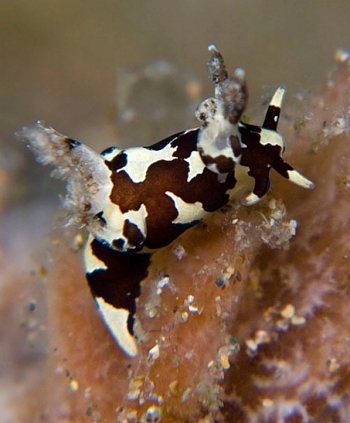
Dear Brian,
Yes it looks like this species is a bit variable in colour. Coming for a dairying country like New Zealand I appreciate your comment about Friesian cows - for those of you who don't a quick Google search will show you the close resemblance.
Concerning your comment that they feed on sponges. This is a common misapprehension based on their common association with certain sponges. Have a look at Sean Kearney's message [#19053] which shows that this species, like all the others we have information on, feed on microscopic stalked animals called kamptozoa, which live in association with the sponges.
Best wishes,
Bill Rudman
Re: Trapania benni? from nthn Mariana Islands
April 9, 2008
From: Yuji Fujie
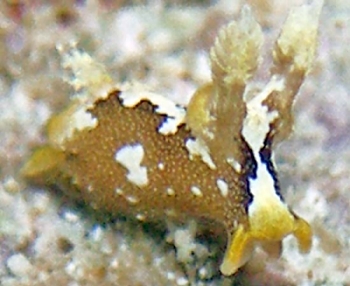
Dear Dr.Bill,
Here are two photos we thought were Trapania benni but, it looks like Trapania dalva, too.
Locality: LauLau Beach, 10 m, Saipan, Northern Mariana Islands, Pacific Ocean, 08 October 2006, under the dead coral. Length: 5 mm. Photographer: Hikoichiro Matsui.
Would you tell us your idea, please ?
Best regards,
Yuji
ds-with@isletwind.com
Yuji Fujie, 2008 (Apr 9) Re: Trapania benni? from nthn Mariana Islands. [Message in] Sea Slug Forum. Australian Museum, Sydney. Available from http://www.seaslugforum.net/find/21504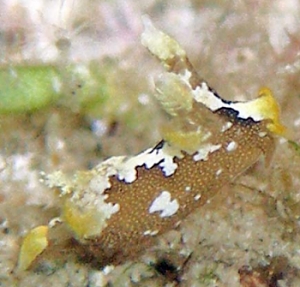
Dear Yuji,
This is a colour form of the newly described Trapania euryeia. It seems the V-shaped white patch on the back of the body, just behind the rhinophores, is a pretty distinctive feature of the species.
Both the species you mention have some colour similarities but T. benni would appear to be a temperate species from sthn Australian waters and T. dalva is from the Caribbean.
Best wishes,
Bill Rudman
Re: Trapania euryeia? from Amami Ooshima Islands, Japan.
March 19, 2008
From: Jun Imamoto
Concerning message #9455:
Dear Bill,
A message thanking you. I have updated the information on my Web site.
Another individual which also seems to be Trapania euryeia, can be found there.
Best Regards,
JunImamoto
imamoto@umiushi.info
imamoto@umiushi.info
Jun Imamoto, 2008 (Mar 19) Re: Trapania euryeia? from Amami Ooshima Islands, Japan.. [Message in] Sea Slug Forum. Australian Museum, Sydney. Available from http://www.seaslugforum.net/find/21458Thanks Jun,
Bill Rudman
Trapania euryeia? from Amami Ooshima Islands, Japan.
March 14, 2008
From: Jun Imamoto
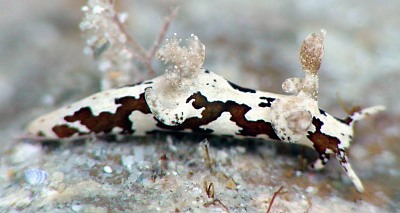
Dear Bill,
In march 2003 my wife visited Amami Ooshima Islands which are at the northern extreme of the Okinawa Islands. Amongst the 60 kinds of sea slugs we saw in 2.5 days was this species. Is this Trapania toddi?
I would be very happy if I could hear your comment.
[Photograph data]
Date: Location: Kurasaki beach, Amami Ooshima Islands, Japan, 14 Mar 2003. Length approx 10 mm. Depth: 5 m. Photos: Jun Imamoto
Best Regards,
Jun Imamoto
imamoto@wips.co.jp
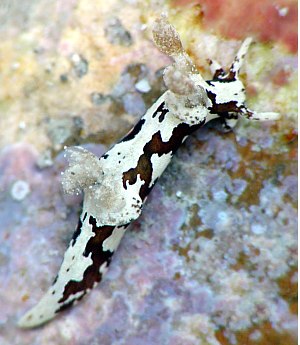
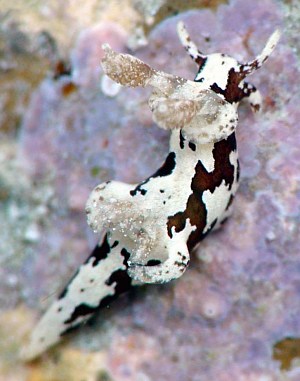
Dear Jun,
I am afraid this is another 'lost message' in the Forum backlog. This seems to be a very extreme colour form of the newly described Trapania euryeia. In these animals there are no small white spots in the dark brown patches.
Best wishes
Bill Rudman
Mystery from Malaysian Borneo
January 4, 2007
From: Sean Kearney
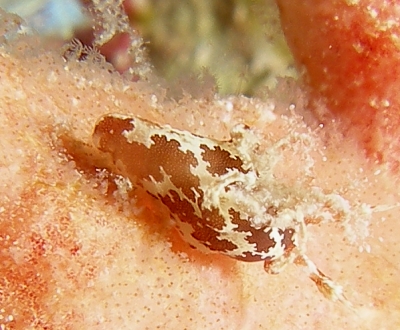
Note added 12 March 2008: This species has been named Trapania euryeia.
Dear Bill,
Please help i.d. this little critter. Can't remember seeing rhinophores like these...there seems to be something extra at the base. Sorry for the lack of better pictures. We were drifting.
Locality: New Lobster Cave, 30 ft, Mabul Island, Malaysian Borneo, Celebes Sea, 18 Oct. 2006, reef wall. Length: 1/2 inch. Photographer: Sean Kearney.
Sean Kearney.
skearney@dc.rr.com
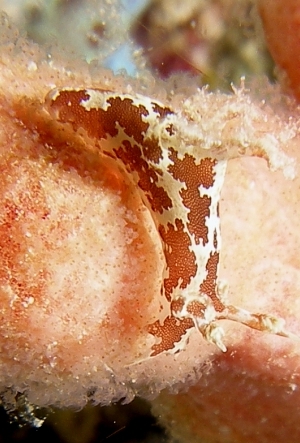
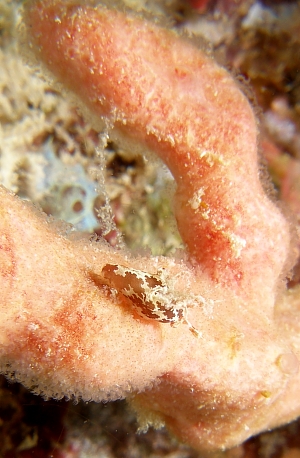
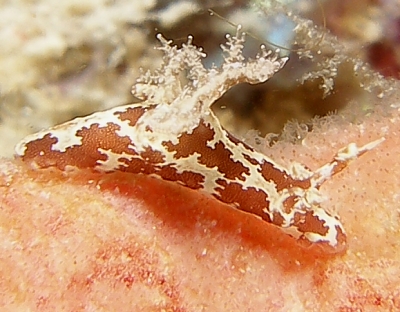
Dear Sean,
This is a species of Trapania, which I am calling Trapania cf brunnea because I am not sure if it is different from Trapania brunnea or not. In your photos it is crawling over a sponge, which is where species of Trapania are often found. Despite your apologies, the photos are excellent. Although the sponge may look out of focus, it is in fact covered with a plant-like growth which is a colony of microscopic animals called kamptozoa on which it feeds. In your upper photo the finger-like feeding tentacles of the kamptozoan zooids can be seen along the top edge of the sponge, and at the bottom of the photo you can see small brown spots, which are the intestinal remains in the gut of each animal. Your photos have enabled me to finish a Fact Sheet on the Kamptozoa. For comparison I have also prepared one on the Bryozoa, another food item of some nudibranchs. Both the Kamptozoa and the Bryozoa were once thought to be closely related.
If you look at other species of Trapania on the Forum, you will see that like your animal, they all have a curved appendage attached to the outer base of each rhinophore stalk.
Best wishes,
Bill Rudman
Trapania cf. brunnea in southern Africa
July 27, 2006
From: Colin Ogden
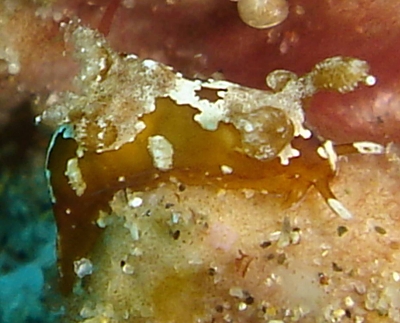
Note added 12 March 2008: This is most probably a species recently named Trapania euryeia.
Concerning message #16316:
Hi Bill,
I attach a photo of what I think is Trapania brunnea found here on one of our reefs. The message from Gary Cobb shows a photo that seems slightly different, therefore the 'cf'. Is my ID correct? I had never seen this before, but have subsequently found another one.
Locality: Sodwana Bay, 12 metres, South Africa, Indian, June 2006, reef. Length: 15mm. Photographer: Colin Ogden.
Thanks for your help
Colin
scubaco@iafrica.com
Ogden C. M., 2006 (Jul 27) Trapania cf. brunnea in southern Africa. [Message in] Sea Slug Forum. Australian Museum, Sydney. Available from http://www.seaslugforum.net/find/17201Dear Colin,
Your animal looks more like Scott Johnson's animals from the Marshall Ids [message #2612] with a white V-shaped mark behind the rhinophores. At this stage I am putting all those animals which have a colour pattern similar to T. brunnea on a Trapania cf. brunnea page, but until we look at their anatomy we won't know whether they are T. brunnea or one, or even two, unnamed species.
Best wishes,
Bill Rudman
Trapania cf. brunnea from Marshall Ids
June 23, 2000
From: Scott Johnson
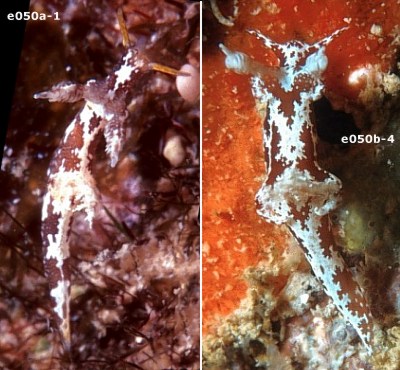
Note added 12 March 2008: This species has been named Trapania euryeia.
Hi Bill,
It looks to me like this species from the Marshall Islands is Trapania brunnea. There is some variation in distribution of white and brown coloration on the body, and one of the specimens, e050a-1, has orange anterior tentacles.
Size range:
e050a-1 = 6mm,
e050 = 16mm long.
Scott
johnson@kmr.ll.mit.edu
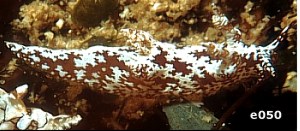
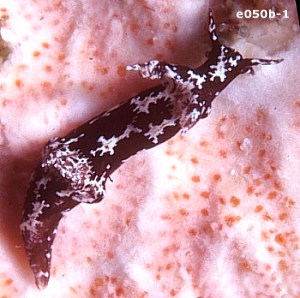
Dear Scott,
It is similar, but I wouldn't be surprised if it is a different species. The white patterning is much more prominent in your animals. The other point is that Trapania brunnea seems to be a southeastern Australian endemic. It has been found in both New South Wales and South Australia, which could be due to tropical currents, but it is also found in Tasmania and Victoria, which usually do not have tropical stragglers.
The radular morphology is a quite useful character in Trapania, but until we know a little about the anatomy of your animal I will be cautious and call it Trapania cf. brunnea.
Best wishes,
Bill Rudman.
